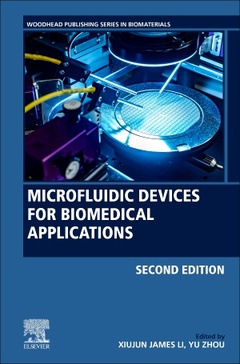Microfluidic Devices for Biomedical Applications (2nd Ed.) Woodhead Publishing Series in Biomaterials Series
Coordonnateurs : Li Xiujun (James), Zhou Yu

Microfluidic Devices for Biomedical Applications, Second Edition provides updated coverage on the fundamentals of microfluidics, while also exploring a wide range of medical applications. Chapters review materials and methods, microfluidic actuation mechanisms, recent research on droplet microfluidics, applications in drug discovery and controlled-delivery, including micro needles, consider applications of microfluidic devices in cellular analysis and manipulation, tissue engineering and their role in developing tissue scaffolds, and cover the applications of microfluidic devices in diagnostic sensing, including genetic analysis, low-cost bioassays, viral detection, and radio chemical synthesis.
This book is an essential reference for medical device manufacturers, scientists and researchers concerned with microfluidics in the field of biomedical applications and life-science industries.
Part I Fundamentals of microfluidic technologies for biomedical applications 1. Materials and methods for the microfabrication of microfluidic biomedical devices 2. Surface coatings for microfluidic-based biomedical devices 3. Actuation mechanisms for microfluidic biomedical devices 4. Droplet Microfluidics for biomedical devices
Part II Applications of microfluidic devices for drug delivery and discovery 5. Controlled drug deliver using microfluidic devices 6. Microneedles for drug delivery and monitoring 7. Microfluidic devices for drug discovery and analysis
Part III Applications of microfluidic devices for cellar analysis and tissue engineering 8. Microfluidic devices for cell manipulation (review type) 9. Microfluidic devices for single cell trapping and automated micro-robotic injection (specific research topic) 10. Microfluidic devices for developing tissue scaffolds 11. Microfluidic devices for stem cell analysis 12. 3D printing and applications
Part IV Applications of microfluidic devices in diagnostic Sensing 13. Development of immunoassays for protein analysis 14. Integrated microfluidic systems for genetic analysis 15. Low-cost assays in paper-based microfluidic biomedical devices 16. Microfluidic devices for viral detection 17. Microfluidics for monitoring and imaging pancreatic islet and betal-cells for human transplant
Medical device manufacturers, scientists, and researchers concerned with microfluidics in the field of drug delivery, cell manipulation, tissue engineering and diagnostics/sensing; Industrial and academic researchers and developers in the life sciences and engineering fields who aim to use microengineering technologies to develop advanced techniques and microdevices for advancements in healthcare and medical diagnostics
Yu Zhou, PhD, is a Research Scientist in the Department of Research and Development at ABS Global Inc., USA. Dr Zhou received his Ph.D. degree in mechan
- Discusses the fundamentals of microfluidics or lab-on-a-chip (LOC) and explores a wide range of medical applications
- Considers materials and methods for microfabrication, microfluidic actuation mechanisms and digital microfluidic technologies
- Details applications of microfluidic devices in cellular analysis and manipulation, tissue engineering and its role in developing tissue scaffolds, and stem cell engineering
Date de parution : 08-2021
Ouvrage de 722 p.
15x22.8 cm
Thèmes de Microfluidic Devices for Biomedical Applications :
Mots-clés :
3D Printing; Acoustic mechanisms; Adsorption; Antibody; Automation; Biomaterials; Biomedical applications; Biomedical research; Bioreactors; Cancer; Cell analysis; Chemiluminescence; Coating; Controlled drug release; Covalent immobilization; Covalent; Cytokine; Diagnostics; DNA sequencing; Droplet microfluidics; Drug delivery strategies; Drug delivery; Drug discovery; Electrochemical detection; Electrokinetics; Electroosmo; Electrotransfection; Environmental testing; Enzyme-linked immunosorbent assay; Fabrication; Fluid and particle manipulation; Fluorescence; Genetic analysis; Glass; Heterogeneous immunoassay; High throughput screening; Human islet transplantation; Immobilization; Immunoassay; Immunosensor; Injection; Inkjet printing; Islet microencapsulation; Islet perifusion; Islet physiology; Lab on a chip; Lab-on-a-chip; Lab-on-chip; Lab-on-paper; Mechanical and nonmechanical actuation; Microdevices; Microelectromechanical systems; Microenvironment; Microfabricated device; Microfabrication; Microfluidic devices; Microfluidic systems; Microfluidic technology; Microfluidic; Microfluidics; microfluidics; Micromanipulation; Microneedle; Microreservoir; Mosaic array; n; Nanofluidics; Nucleic acid detection; Pancreatic islet of langerhans; Paper-based microfluidics; Pathogen detection; Pharmaceutical analysis; Photolithography; Point-of-care diagnostics; Point-of-care testing; Point-of-care; Polymer; Polymers; Robotics; Scaffolds; Screening; Short tandem repeat analysis; Silicon; Single cells; Single-phase; sis; Small organisms; Soft lithography; Stem cell analysis; Stem cell; Stem cells; Surface acoustic waves (SAWs)Surface property; Threads; Tissue engineering; Tissue genesis; Transdermal delivery; Triggered system; Vascularizatio; Viral infection; Xurography



